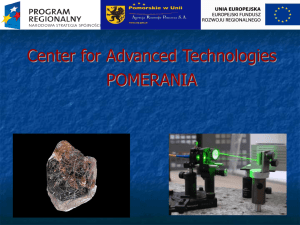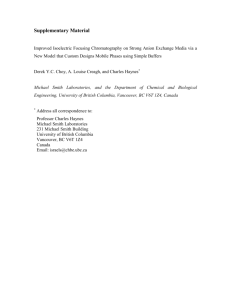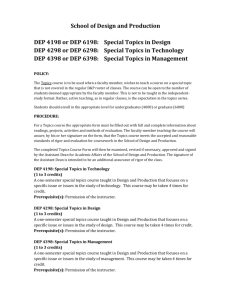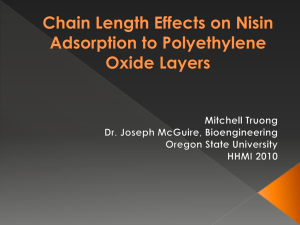Electronic_Supplementary_Material_v9_1342650255_1
advertisement
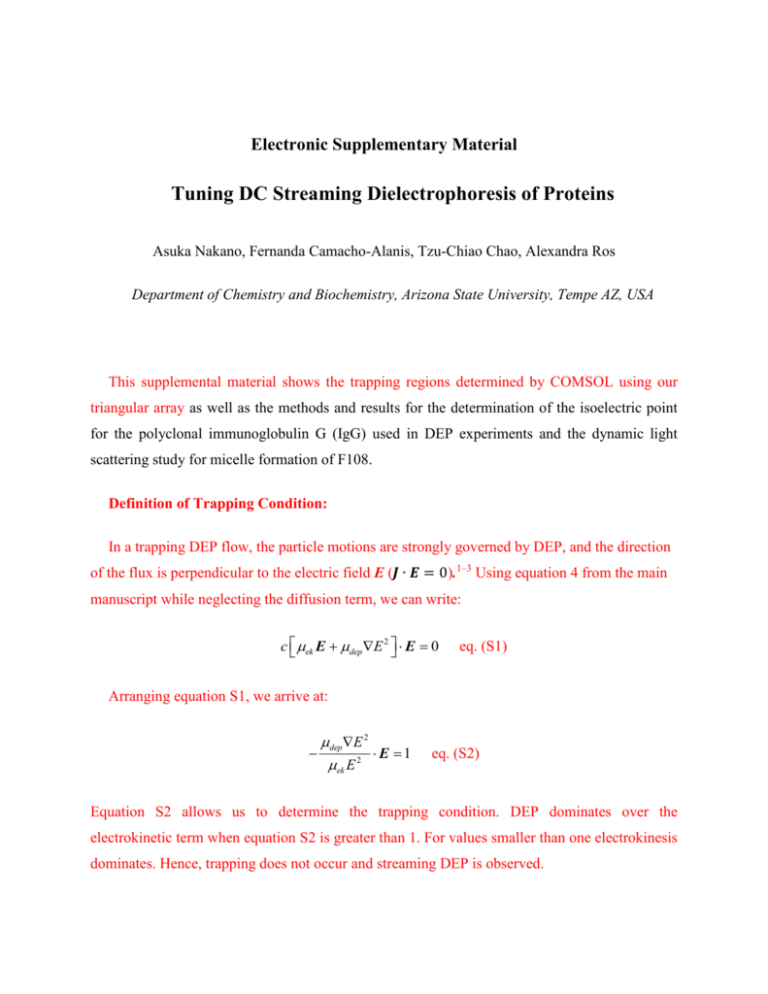
Electronic Supplementary Material Tuning DC Streaming Dielectrophoresis of Proteins Asuka Nakano, Fernanda Camacho-Alanis, Tzu-Chiao Chao, Alexandra Ros Department of Chemistry and Biochemistry, Arizona State University, Tempe AZ, USA This supplemental material shows the trapping regions determined by COMSOL using our triangular array as well as the methods and results for the determination of the isoelectric point for the polyclonal immunoglobulin G (IgG) used in DEP experiments and the dynamic light scattering study for micelle formation of F108. Definition of Trapping Condition: In a trapping DEP flow, the particle motions are strongly governed by DEP, and the direction of the flux is perpendicular to the electric field E (𝑱 ∙ 𝑬 = 0).1–3 Using equation 4 from the main manuscript while neglecting the diffusion term, we can write: c ek E dep E 2 E 0 eq. (S1) Arranging equation S1, we arrive at: dep E 2 E 1 ek E 2 eq. (S2) Equation S2 allows us to determine the trapping condition. DEP dominates over the electrokinetic term when equation S2 is greater than 1. For values smaller than one electrokinesis dominates. Hence, trapping does not occur and streaming DEP is observed. Figure S1. Plotting the trapping condition (equation S2) using COMSOL for proteins in the triangular structure as employed in the main manuscript. The applied potential is 4200 V in a 1cm long channel, dep of 8.6x10-24 m4/V2s and ek of 1.5x10-8 m2/Vs. In Figure SI-1 we present equation SI-2 computed with Comsol Multiphysics with an applied potential of 4200 V in a 1cm long channel. The mobilities for both cases were dep=8.6x10-24 m4/V2s as determined by eq. 3 from the main manuscript and ek=1.5x10-8 m2/Vs. We thus conclude that the trapping condition is not satisfied for this device because all are in the order of 1x10-4 or smaller. Therefore, streaming behavior is expected to occur for proteins in this iDEP device. We note, that streaming DEP is indeed observed in the here presented device experimentally. Thus, a possible cause for experimentally observed trapping in devices with similar or even larger post distances could originate from aggregate formation, as for example reported by Lapizco-Encinas et al.4 With IgG, this is the case at pH ranges below 6 and above 8 in the here presented triangular post array (see main manuscript). Isoelectric focusing: To investigate the isoelectric point of IgG used for DEP experiments, isoelectric focusing (IEF) was performed as reported earlier5 with slight modifications. In short, protein samples were first desalted using centrifugal filters (Amicon Ultra-0.5 Ultracel-50 Membrane 50 kDa, Millipore, MA, USA). Subsequently, 100µL of 2 mg/mL IgG protein (Invitrogen, Carlsbad, CA, USA) with or without 3 µL of IEF protein standard (Bio-Rad, Hercules ,CA, USA) were suspended in 350 µL rehydration buffer composed of 50% glycerol and 2% w/v CHAPS. The protein solution was loaded on IPG strips (Bio-rad, Hercules , CA, USA) of 24 cm length and linear pH gradient of 3-10 by means of passive rehydration. Protein was focused using a Protein IEF cell (Bio-rad) at 20 °C using a rapid ramp up to 8000 V continuing until 80 kVh were reached. After IEF, the strips were fixed for 2-3 hours in a fixation solution composed of 10 % acetic acid, 40 % ethanol and water. Scanning of strips was performed with a scanner (Scanmaker i800, Microtek, CA, USA). Figure S2 a-b shows the IPG strips for a) IEF protein standard of pI range 4.45–9.6 (Bio-rad, CA, USA) and b) the polyclonal Alexa488-labelled IgG, respectively. Numbers denote (1) phycocyanin with pI 4.45, 4.65 and 4.7, (2) myoglobin with pI 6.8 and 7 and (3) cytochrome C with pI 9.6 are naturally colored, thus they can be visualized without staining (see Figure 1S-a), while for the strips with Alexa488-IgG we can observe a broad, yellow band (Figure 1S-b). We expected the pI range to be broad due to the polyclonal origin of IgG as well as glycosylation. Upon comparison of two strips we found that the pI of Alexa488-IgG is below 5. Figure S2: IEF of protein standard and polyclonal IgG protein. (a) The IPG strip contains IEF isoelectric point (pI) protein standards: (1) phycocyanin (pI 4.45, 4.65, 4.75), (2) myoglobin (6.8, 7.0) and (3) cytochrome c (9.6). (b) The IPG strip of fluorescently labeled Alexa488-IgG. Dynamic light scattering (DLS): We employed dynamic light scattering (DLS) in order to investigate F108 micelle formation above the critical micelle concentration (cmc) in relation to the negative DEP behavior we observed under F108 dynamic coating condition. DLS measurement was performed using a DynaPro NanoStar instrument (Wyatt Technology Corp. Santa Barbara, CA, USA). Data collection and analysis were performed with the instrument’s software DYNAMICS. For sample preparation, all buffers were filtered with a 20 nm filter with IgG protein. We studied the temperature dependent micellation of F108 with a 3.3 nM IgG sample diluted with pH 8 phosphate buffer containing 3mM F108 and 1.6 mM CHAPS. Figure S3-a shows that the light scattering intensity increases drastically above 25 °C, indicating the formation of larger species at this temperature presumably arising from F108 micelle formation. The size distribution in Figure S3-b at temperatures below and above the critical micelle concentration clearly indicates the formation of large species at elevated temperature. The observed size of this species (~9.7 nm) in our experiment is in excellent agreement with the previously reported value of ~10 nm for F108 micelles by Alexandridis et al..6 We thus conclude, that F108 micelles are present at iDEP conditions used in our study (see main manuscript). Figure S3: Results of DLS study: (a) scattering light intensity plotted as a function of temperature from 20 °C to 50 °C. The abrupt increase in light scattering intensity at 30 °C indicates the formation of F108 micelles. (b) radius distribution in terms of % intensity for a 3mM F108 containing 3.3 nM Alexa488-IgG sample and 1.6 mM CHAPS. References 1 R. Davalos, G. McGraw, T. Wallow, A. Morales, K. Krafcik, Y. Fintschenko, E. Cummings, and B. Simmons, Anal. Bioanal. Chem. 390, 847 (2008). 2 J.L. Baylon-Cardiel, B.H. Lapizco-Encinas, C. Reyes-Betanzo, A.V. Chávez-Santoscoy, and S.O. Martínez-Chapa, Lab Chip 9, 2896 (2009). 3 J.-S. Kwon, J.-S. Maeng, M.-S. Chun, and S. Song, Microfluid. Nanofluid. 5, 23 (2008). 4 B.H. Lapizco-Encinas, S. Ozuna-Chacón, and M. Rito-Palomares, J. Chromatogr., A 1206, 45 (2008). 5 T. Chao, J. Kalinowski, J. Nyalwidhe, and N. Hansmeier, Proteomics 10, 1673 (2010). 6 P. Alexandridis, T. Nivaggioli, and T.A. Hatton, Langmuir 11, 1468 (1995).



